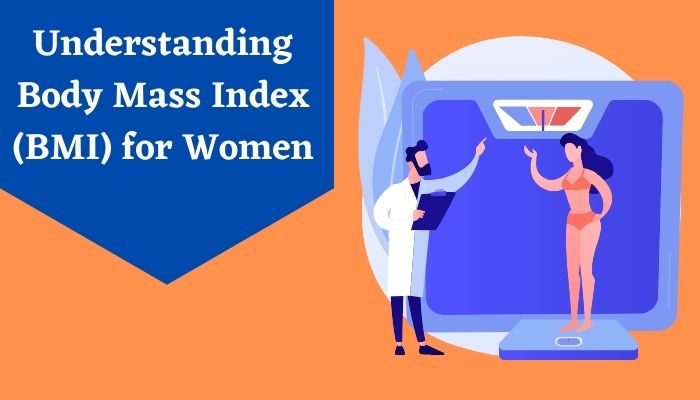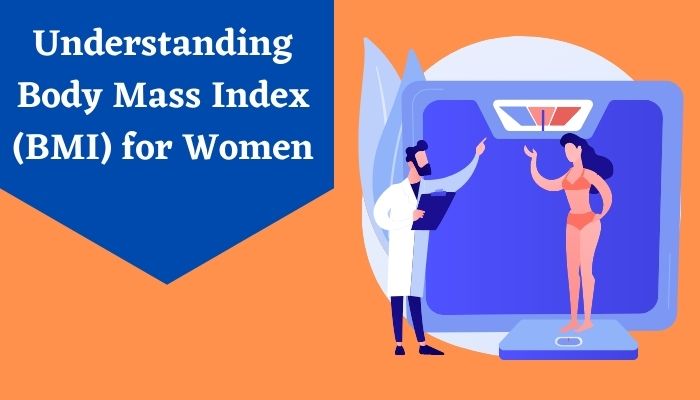BMI is a measure of body fatness and is calculated by dividing your weight in kilograms by your height in meters squared. For example, if you weigh 70 kg and are 1.7 m tall, your BMI would be:
70 ÷ (1.7)² = 24.22
For women, BMI is determined by dividing weight (in kilograms) by height (in meters) squared. A BMI of 18.5 to 24.9 is considered normal weight, a BMI of 25 to 29.9 is overweight, and a BMI of 30 or greater is obese.
BMI can be a useful tool for assessing whether a woman's weight is in a healthy range, but it is not the only factor to consider when assessing her health. You should also look at your waist circumference, as having too much fat around your waist can increase your risk of health problems.
If you are concerned that you may be overweight or obese, talk to your health care provider about ways to lose weight safely.
A BMI of 25 or greater is associated with an increased risk of developing diseases such as high blood pressure, heart disease, type 2 diabetes, and certain cancers.
Understanding Body Mass Index (BMI) for Women
For women, BMI is determined by dividing weight (in kilograms) by height (in meters) squared. A BMI of 18.5 to 24.9 is considered normal weight, a BMI of 25 to 29.9 is overweight, and a BMI of 30 or greater is obese.BMI can be a useful tool for assessing whether a woman's weight is in a healthy range, but it is not the only factor to consider when assessing her health. You should also look at your waist circumference, as having too much fat around your waist can increase your risk of health problems.
If you are concerned that you may be overweight or obese, talk to your health care provider about ways to lose weight safely.
BMI is not the only factor to consider when assessing your health. You should also look at your waist circumference, as having too much fat around your waist can increase your risk of health problems.
BMI chart for women
What is the normal BMI for women?
Normal BMI for women ranges from 18.5 to 24.9, and it indicates normal weight, a BMI of 25 to 29.9 is overweight, and a BMI of 30 or greater is obese.BMI chart for adult women according to the World Health Organization
|
BMI range |
Category |
|
<17 |
Thinness |
|
<18.5 |
Underweight |
|
18.5–24.9 |
Normal weight |
|
≥25 |
Overweight |
|
≥30 |
Obese |
The implications of the weight categories mentioned in the BMI chart for women are explained below:
- Thinness A BMI index for women of <17 is indicative of thinness, which is linked to probable increase in illness and poses moderate risk to the women’s health. However, if an adult woman has a BMI < 16, it is a sign of major concern. This can be considered as an extreme limit, as it is associated with the increased risk of bad health, poor physical performance, lethargy, and even death (in some cases). A woman who falls under this category must seek medical attention immediately.
- Underweight Women who have a BMI index of < 18.5 are considered underweight. This category does not have a significant increased risk of illness as long as the BMI for a woman remains over 17. People who fall under this category are advised to keep a watch on their BMI and avoid it from dropping below 17.
- Overweight For women, BMI ≥ 25 signifies overweight. Women who fall under this category have a high chance of developing chronic non communicable diseases (NCDs) such as coronary heart disease and stroke. It also increases the risk of several types of cancer, musculoskeletal disorders, respiratory ailments, etc. The range of 18.5 to 24.9 is considered normal BMI for women, and many people use this criterion to plan their diet and exercise and implement changes in their lifestyle.
- Obesity A woman who has a BMI of ≥30 falls under the obese category. Doctors usually recommend such individuals to make lifestyle changes and reduce excess weight to stay in the normal weight category for optimum health. Obesity can have adverse effects on a person’s life including an increased risk of illnesses and premature death.
How to maintain a normal BMI?
Maintaining a healthy weight and waist circumference is important for reducing your risk of health problems such as high blood pressure, heart disease, type 2 diabetes, and certain cancers.Some suggestions to lose weight safely and maintain a healthy BMI include

- Avoiding sugary drinks and processed foods: Sugary drinks are high-calorie, low-nutrient beverages that are usually loaded with sugar. Instead of sugary drinks, drink water or other unsweetened beverages instead. Processed foods include chips, candies, and other highly processed snacks. If you eat these types of foods, try to replace them with healthier options like fresh fruits and vegetables.
- Avoiding alcohol: Alcohol can also contribute to weight gain. When you drink, it is easy to be unaware of how much you are actually drinking and consume more calories than if you were not intoxicated
- Eating a healthy diet that is low in calories and saturated fat and being physically active: Include lots of different types of vegetables and fruit in your diet and eat whole grains instead of refined grains. Be physically active for at least 30 minutes each day.
-Staying hydrated: Drink plenty of fluids, especially water. Avoid sugary drinks and processed foods: Sugary drinks are high-calorie, low-nutrient beverages that are usually loaded with sugar. Instead of sugary drinks, drink water or other unsweetened beverages
-Not smoking: Smoking increases your risk for heart disease, lung cancer, emphysema, stroke, and other serious health problems.
-Limiting alcohol intake: When you drink, it is easy to be unaware of how much you are actually drinking and consume more calories than if you were not intoxicated
-Exercising regularly: If your weight is healthy, aim for physical activity that gets your heart rate up for at least 30 minutes each day. If you are trying to lose weight, you may need to exercise more.
-Maintaining a healthy weight and waist circumference: This is important for reducing your risk of health problems such as high blood pressure, heart disease, type 2 diabetes, and certain cancers.
-Taking care of yourself: Not feeling good about yourself, not having friends or family who support you, and being in a negative environment can all contribute to stress levels. Being stressed can also make it harder to take care of yourself.
-Having a good support system: Support can come from anywhere, including family, friends, or online communities. It is important to have people you can turn to for help staying on track with your weight loss goals.
BMI for Asian women
A study revealed that south Asian women have relatively high levels of body fat than women of white descent. Health conditions like type 2 diabetes occur at a low BMI for women of South Asia.BMI for women athletes and bodybuilders
Since the BMI index for women is calculated on the basis of two factors—their height and weight—it is not always an accurate measure of a person’s overall health. BMI for women cannot measure their fat or muscle mass separately, it uses the total mass/weight of a person. Thus, women who have a significantly high muscle mass and low-fat levels, such as athletes, should use a different system to evaluate their health.BMI for pregnant women
The weight of a pregnant women during pregnancy, also known as gestational weight, is strongly related to the weight of the women before they got pregnant according to a 2018 study. The observations of that study recorded for more than 2,10,000 women are listed below:|
Pre-pregnancy BMI category |
Average gestational weight gain at 40 weeks |
|
Underweight |
14.2 kg |
|
Normal weight |
14.5 kg |
|
Overweight |
13.9 kg |
|
Obese (grade 1) |
11.2 kg |
|
Obese (grade 2) |
8.7 kg |
|
Obese (grade 3) |
6.3 kg |
BMI for women after menopause
As women get older, muscle mass in their body tends to reduce. Additionally, hormone levels in their body change drastically after menopause, which contributes to reduced agility, declining bone health, and other health problems. A post-menopausal woman will have different health from a woman in her 20s even if they have the same BMI. Thus, the regular BMI index for women is not an accurate marker of health and obesity for women who have had menopause.Which foods should be consumed to reduce BMI?

Eat lots of different types of vegetables and fruit, whole grains, and low-fat dairy products. Choose lean meats, poultry, and fish like salmon for protein. Limit saturated fat by choosing lower-fat options such as skim or 1% milk, lean cuts of meat, and skinless chicken breasts. Avoid sugary drinks and processed foods; instead, drink water or other unsweetened beverages.
What are the risk factors for high BMI?
If you are over age 50, have a family history of early heart disease, or have high blood pressure, diabetes, or abnormal cholesterol levels, you are at higher risk for health problems related to being overweight. Being physically inactive, having poor eating habits, and being unhappy with your weight also increase your risk.Obesity Chart Female
Weight (pounds)-Height (feet, inches)120 -4'3"
132 -4'6"
144 -4'9"
156 -5'0"
168- 5'3"
180-5'6"
192- 5'9"
204- 6'0"
What is the Average BMI for Women?
The average BMI for women is 25.7, which falls within the "overweight" category. However, about 33.4% of women have a BMI in the "normal" range (18.5-24.9), and only 2.6% have a BMI in the "underweight" category. The majority of women (about 60%) have a BMI in the "overweight" and "obese" range (25.0-29.9).What is the average weight for women?
The average weight for an adult woman is 166 pounds or 74 kilograms; however, this varies greatly by age and build. The average weight for a five-foot,five-inch woman is 145 pounds or 66 kilograms. For a five-foot, four-inch woman, the average weight is 136 pounds or 62 kilograms. And for a five-foot, three-inch woman, the average weight is 127 pounds or 58 kilograms.The bottom line Now you can keep a tab on your overall health by monitoring your BMI over time as you grow older or start a family. One can use the simple formula to calculate BMI index for women:
BMI = Weight in Kg/(height in m)2
BMI has been used as a standard measure for categorising people in different weight categories, including underweight, normal weight, and overweight. However, it is not always accurate for women as their body change quite dramatically with time and major events such as pregnancy; additionally, ethnicity also plays a minor role in the categorisation of women according to their BMI. Although BMI for women is a quick and convenient health assessment generally, one should not rely on its accuracy as there is no one-size-fits-all, especially when it comes to human bodies.
There are numerous benefits of BMI as well, despite its obvious shortcomings. In a world of over 7.2 billion people, BMI is an easy, effective, and economical way for researchers to track the obesity of the human population, which plays an important role in medical research. BMI for women can be used as a reliable factor along with other factors in medical diagnosis. If you or a woman you care about falls under the thinness or obese category, it is best to check with a doctor to improve her BMI in order to avoid diseases and reduce the risk of premature death. The doctor can suggest some changes in the diet and lifestyle to get the person in the range of normal BMI for women.



